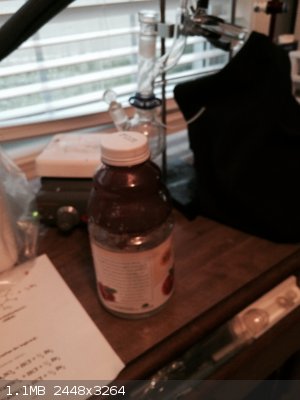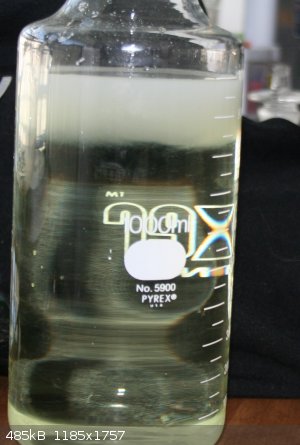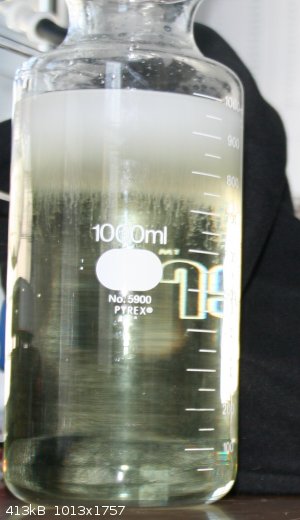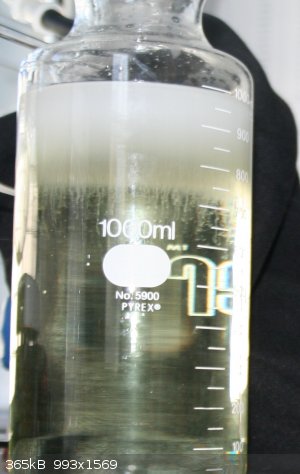CaptainPike
Hazard to Self
 
Posts: 68
Registered: 21-12-2012
Member Is Offline
Mood: No Mood
|
|
a neglected halo–form
I needed some chloroform, and repeated a procedure I have used several times. This procedure was presented in a YouTube video by the well-known and
very capable UC235.
I had what looked like a good yield of chloroform in my ruby red sep funnel, but there it had to stay, underneath the alkaline salt water, etc., which
is left over from the halo-forming, for what I really intended would be only a day or two.
It was two weeks before it was gotten out from behind my monitor. All that was left as evidence was a grimy little circle where the surface of the
shiny, oily chloroform had been! Then I remembered the words of this young man who teaches responsibility with the disposal of the byproducts we
necessarily create in the pursuit of this foolishness. He said that the amount of alkaline salt water solution left over was sufficient to neutralize
50% of the theoretical yield of this procedure. Well, it was a relatively good yield – for me, at least. I can't even turn the stopcock
myself but enjoy this hobby by proxy, using assistants to whom I am grateful.
But there it was, gone! A single phase, greenish solution having an odd, viscous look to it. About how I would look after munching down a couple of
moles of chloroform. I saved it. Could I get some sodium formate out of it? Or could I add in some energy and some elemental gases and move back to
the left again?
It's pretty amazing really. No phase boundary catalyst. Only a few cm² surface area between the two. That low actinic glass, up-on-the-dark-shelf
location should have made for pretty hard work. I wonder if the phase boundary moved slowly downward as the chloroform got absorbed, or whether it
just dissipated in situ. And this: this all happened in a 500 mL volume! This was the last half liter from the jug! Most of the supernatant had been
poured off. Whatever it is, it must be pretty strong stuff. Any ideas will be a delightful fresh breeze blowing into my corner of the world.
I should have known – I did know. My condition necessitates periodic reevaluation of priorities.
please excuse blurry photo, this is where we put the single phased offender – my assistant thought the bottle was red plastic. It was actually
Cranbury juice.

|
|
|
macckone
International Hazard
    
Posts: 2159
Registered: 1-3-2013
Location: Over a mile high
Member Is Offline
Mood: Electrical
|
|
With a witches brew like that I would recommend extreme care. Probably best to open it outdoors as phosgene could form although it is unlikely if the
solution was alkaline. If it is extremely alkaline then letting it set likely destroyed the chloroform. Getting anything useful out is doubtful.
You may have sodium formate, chloroformates, sodium chloroacetate, and various other partially halogenated compounds. If the solution is no longer
alkaline from breaking down chloroform, then phosgene could have formed as well as a lot of other partially halogenated acetates and formates.
Phosgene is relatively unlikely if the container was sealed as oxygen is necessary. If you want to do anything with it, I would suggest first adding
sodium carbonate to neutralize any acids and then extract the water solution to remove any non-polar or slightly polar chlorocompounds. Otherwise
just add sodium hydroxide and let it set until the greenish color disappears (may require reflux), then neutralize with vinegar, then dispose of it.
|
|
|
CaptainPike
Hazard to Self
 
Posts: 68
Registered: 21-12-2012
Member Is Offline
Mood: No Mood
|
|
some more images.
These photos show the addition of a few more milliliters of acetone to an already partially depleted bleach solution. Probably less than 0.5% sodium
hypochlorite remaining in this to 1 L fleeker. After one minute, two minutes and five minutes.
  
|
|
|
CaptainPike
Hazard to Self
 
Posts: 68
Registered: 21-12-2012
Member Is Offline
Mood: No Mood
|
|
… and another thing! (Pardon my shameless re-fibrillation of this thread)
Looking at this picture, and others like it, shows pretty much what you'd expect. The acetone weighs less than the bleach solution, so it makes sense
that it will more or less float around on top of this aqueous layer, getting nipped at by hydroxyl radicals, hydroxyl piranha, snipping off methyl
fingertips… okay, so I got a little carried away.
The point I'm driving at here is something like this: by whatever mechanism you choose to believe, those light weight, bouncy little hydrogen protons,
making up the methyl groups of the keytone were just like pieces of a life preserver; replacing them with the heavier chlorine atoms systematically
weights the molecule down,and then especially when chloroform is actually produced, it's going to drop down through that aqueous layer because now
it's heavier than everything else.
Please correct me, since I am a total newbie here. In the perfect world of the acetone's (or other keytone)lying on top, the stepwise transformation
of it's methyl group (of that keytone)
and its ultimate secession from the molecule altogether(CCl3) – all happening in the phase boundary. Then, sure, the chloroform just drops to the
bottom.
But what if instead, the jug is shaken up vigorously, all that molecular intercourse occurs wherever – all over the place. Then could not a drop of
newly formed chloroform mix in with some acetone it meets on the way to the bottom, happily remaining azeotropic, with hopes of messing up some
reaction where pure chloroform was what was wanted?
So, what if the process included some kind of misting of the keytone on top of the sodium hypochlorite solution(instead of shaking)? Would that help
to keep the acetone-chloroform azeotrope from forming, or would it just introduce some other problem?
I think this has been happening in my preparation. And okay, I have not been slapped around on this forum yet. It's okay, if I am totally nutty and
sophomoric– set me straight, please!
|
|
|
|